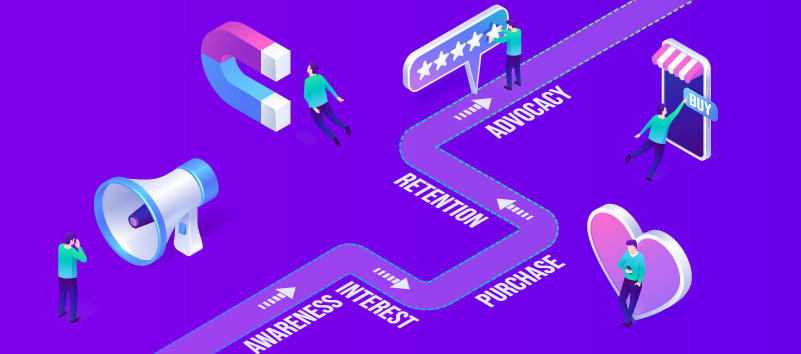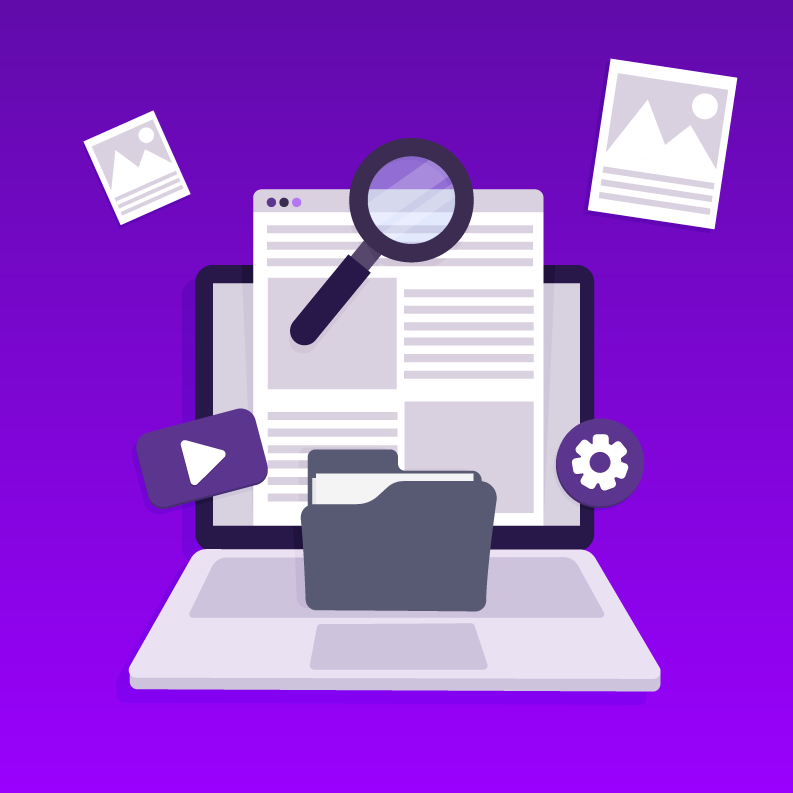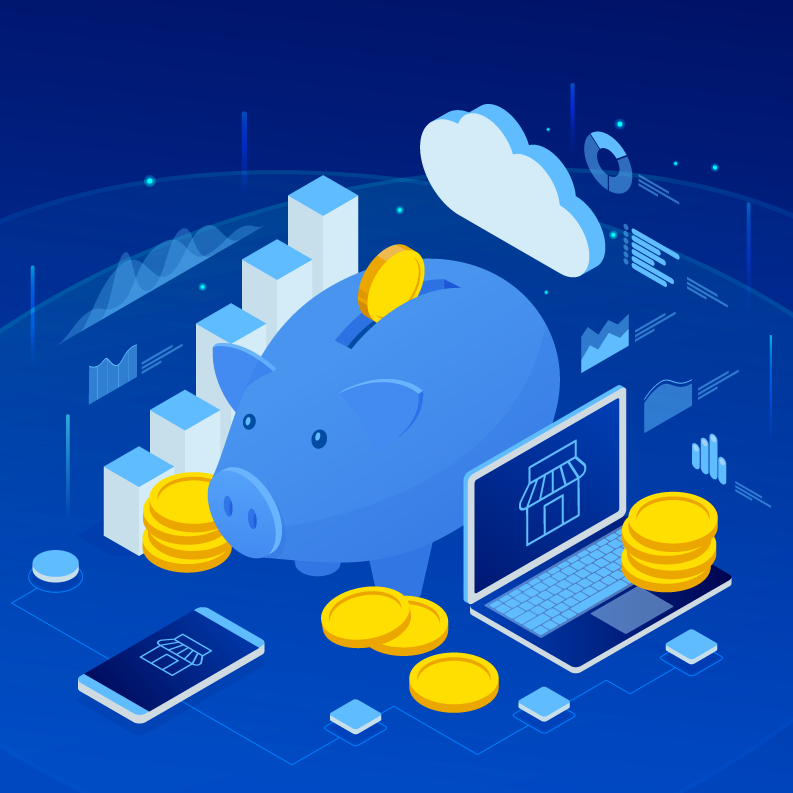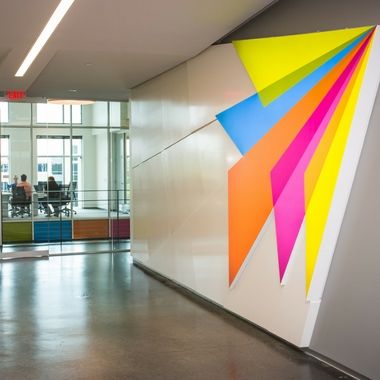You’re online browsing for a shirt and find a few options. You decide to look into one option and decide it’s not the right one for you and abandon the cart. You start to see that shirt on social media and in your ads online until finally, you decide to make the purchase.
Buying items online is no longer as simple as viewing an item, adding it to your cart and making a purchase. There are stages to the customer journey and it’s important to create a strategy for each because customers not only purchase from your brand but will come back to your brand.
The Five Customer Journey Stages
So, what are the stages in the customer journey? At Rithum, we break it down into five distinct stages.
- Awareness. At this stage, the customer discovers products and starts to get interested in making a potential purchase.
- Consideration. Customers are not quite ready to make a purchase at this stage. They take time to evaluate the product by looking at prices, reviews and delivery time.
- Motivation. This can really be the moment to help lead into the next stage of conversion. Specific conditions could encourage a decision to make the purchase, such low stock notifications.
- Conversion. It’s self-explanatory, but this is the stage where the customer makes the purchase.
- Loyalty. While businesses may consider conversion to be the end of the journey, it’s important to remember that these customers can become lifelong buyers of your brand and might even become ardent supporters.
We’ll go in-depth to provide strategies and intent-focused content for each stage of the journey to help you retain customers until the end and even long after.
Tips for the Customer Journey Stages
Awareness
There are two types of awareness: pre-awareness and product awareness. With pre-awareness, customers are not looking for any specific product and are “window shopping” online. Product awareness is the time period when the customer has a broad idea of what type of item they want to purchase. Intentional strategies can help you reach customers during this stage.
A great place to start is marketplace advertising such as Amazon Advertising. In fact, our recent global survey showed 89% of shoppers browse items on online marketplaces like Amazon or eBay without the intention to purchase. This is a great opportunity to bring your products or brand to their attention as they search for products.
Strong social media presence is a must in this day and age. Forty-seven percent of 18- to 25-year-old customers discovered products they purchased through social media feeds such as Facebook, Instagram or Tiktok. Create social channels on these platforms and target audiences with paid social ads like Facebook Ads or Stories Ads. Find influencers to work with who use and love your brand too.
Don’t underestimate TikTok, in particular. Forty-eight percent of Gen Z is on TikTok, and millennials, Gen X and baby boomers make up 51% of the user base. This is a channel you don’t want to miss out on when it comes to advertising. From In-Feed Ads to Brand Takeover Ads, the platform offers plenty of ways to get in front of potential customers.
Consideration
The customer has found the product they are looking for, but they are not quite ready to hit purchase. They want to do some more research and take a look at reviews, return policies and prices.
Price is something a lot of customers consider when making a purchase. The vast majority (83%) of customers in our survey said they usually compare prices before making a purchase. Provide ways for customers to consider the best deal such as signing up for a newsletter or giving discount codes.
Aside from price, customers want to know everything they can about the product they are purchasing online. A robust and detailed product description will help to sway customers to purchase. Amazon is a great example as 50% of customers trust the marketplace giant to have the most accurate product information. Add high-resolution photos, videos and item-specific details on the page. Be consistent across all channels on which you list the product. Customers are more likely to shop where they find accurate product information.
Motivation
Motivation can be tied closely to the consideration phase. At this point, the customer is really on the fence about purchasing the product. They can be swayed one way or another at this stage.
You want to find ways to encourage and entice them to make the purchase. Think about retargeting efforts. Retargeting ads can be a good place to start. Keep your brand in front of these customers by splitting retargeting efforts based on visitor behavior. It could target those who clicked through your site and pages and showed interest in your product or brand.
Think about cart abandonment emails. Customers may add products to cart and decide to sit on whether they should or should not follow through with their purchase. Sending staggered, personalized emails will help bring these products back to their attention. Providing an incentive with discounts like 10%-15% off their first purchase can really make the difference here with over 75% of customers stating that price is very important when choosing products.
A pro tip for this phase is to remember that finding the right motivators to entice customers to complete a purchase may take some trial and error. You may need to create A/B test emails with different messaging or content — but remember to only change one element when executing the test emails (for example, change the subject line or the images used).
Conversion
If your customer has reached this stage, they are ready to complete their purchase, so what could possibly go wrong? Well, cart abandonment remains a possibility. According to our survey, over 50% of men and women have completely abandoned their cart due to an out-of-stock product. More than 40% suspected the product price could be better or be lower in the future.
Make the checkout process as easy and seamless as possible to avoid hesitation during the conversion. Think about whether your checkout experience is mobile-friendly as customers browse and purchase from their phones.
Other ways to make the experience simple is to allow customers to check out as a guest to bypass the tedious process of creating an account. Provide multiple payment options and remove surprise taxes, fees or shipping costs.
Give customers multiple options for how and where they complete their purchase, such as the ability to “click and collect” (buy online, pick up in-store). In Australia, fifty-four percent of customers have used the “buy online, pick up in-store” option when shopping online. If it’s possible, give them this option.
Loyalty
Finally, the customer makes the purchase. Your work is done, right? Think again. Even after the purchase, you want to foster loyalty with your customers, so they will come back to your brand when they think about purchasing again.
Send them clear post-checkout communications such as a “thank you” confirmation email and keep them updated on the progress of their shipped package. You’ll want to reply to any questions customers send quickly, and ask them for feedback on their experience with your brand and the product. Respond to the good and the bad.
Stay regularly engaged with these customers in the long run through newsletters or exclusive discounts. Using your brand’s social presence, you can maintain consistent connection by creating a social experience for your followers through giveaways or rewards.
Customers want to feel appreciated and part of something unique, so having loyalty clubs only customers can join or providing unique advantages to existing customers will help encourage them to continue considering the brand and keep coming back.
—
Contact us today to learn how Managed Services can help you in each stage of the customer journey.
Editor’s Note: This post was originally published in November 2021 and was updated in November 2022 for accuracy and comprehensiveness.




